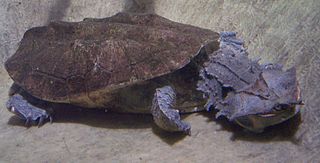
Equidae is the taxonomic family of horses and related animals, including the extant horses, donkeys, and zebras, and many other species known only from fossils. All extant species are in the genus Equus, which originated in North America. Equidae belongs to the order Perissodactyla, which includes the extant tapirs and rhinoceros, and several extinct families.
Genus is a taxonomic rank used in the biological classification of living and fossil organisms as well as viruses. In the hierarchy of biological classification, genus comes above species and below family. In binomial nomenclature, the genus name forms the first part of the binomial species name for each species within the genus.

In taxonomy, binomial nomenclature, also called binominal nomenclature or binary nomenclature, is a formal system of naming species of living things by giving each a name composed of two parts, both of which use Latin grammatical forms, although they can be based on words from other languages. Such a name is called a binomial name, a binomen, binominal name or a scientific name; more informally it is also called a Latin name.

The lagomorphs are the members of the taxonomic order Lagomorpha, of which there are two living families: the Leporidae and the Ochotonidae (pikas). The name of the order is derived from the Ancient Greek lagos + morphē. There are 110 recent species of lagomorph of which 109 are extant, including 34 species of pika, 42 species of rabbit, and 33 species of hare.

The family Psittacidae or parrots is one of three families of true parrots. It comprises the roughly 10 species of subfamily Psittacinae and 157 of subfamily Arinae, as well as several species that have gone extinct in recent centuries. Some of the most iconic birds in the world are represented here, such as the blue-and-gold macaw among the New World parrots and the grey parrot among the Old World parrots.

The Faboideae are a subfamily of the flowering plant family Fabaceae or Leguminosae. An acceptable alternative name for the subfamily is Papilionoideae, or Papilionaceae when this group of plants is treated as a family.

Opossums are members of the marsupial order Didelphimorphia endemic to the Americas. The largest order of marsupials in the Western Hemisphere, it comprises 120+ species in 19 genera. Opossums originated in South America and entered North America in the Great American Interchange following the connection of North and South America.

Anseriformes is an order of birds also known as waterfowl that comprises about 180 living species of birds in three families: Anhimidae, Anseranatidae, and Anatidae, the largest family, which includes over 170 species of waterfowl, among them the ducks, geese, and swans. Most modern species in the order are highly adapted for an aquatic existence at the water surface. With the exception of screamers, males have penises, a trait that has been lost in the Neoaves. Due to their aquatic nature, most species are web-footed.

Laridae is a family of seabirds in the order Charadriiformes that includes the gulls, terns and skimmers. It includes around 100 species arranged into 22 genera. They are an adaptable group of mostly aerial birds found worldwide.

Colubridae is a family of snakes. With 249 genera, it is the largest snake family. The earliest species of the family date back to the Oligocene epoch. Colubrid snakes are found on every continent except Antarctica.

Chelidae is one of three living families of the turtle suborder Pleurodira, and are commonly called Austro-South American side-neck turtles. The family is distributed in Australia, New Guinea, parts of Indonesia, and throughout most of South America. It is a large family of turtles with a significant fossil history dating back to the Cretaceous. The family is entirely Gondwanan in origin, with no members found outside Gondwana, either in the present day or as a fossil.

The Gnaphalieae are a tribe of flowering plants in the family Asteraceae. It is most closely related to the tribes Anthemideae, Astereae, and Calenduleae.
Isospora is a genus of internal parasites in the subclass Coccidia.

André Jean Baptiste Robineau-Desvoidy was a French physician and entomologist specialising in the study of Diptera (flies) and to some extent of the Coleoptera (beetles).

Talpa is a genus in the mole family Talpidae. Among the first taxa in science, Carolus Linnaeus used the Latin word for "moles", talpa, in his Regnum Animale to refer to the commonly known European form of mole. The group has since been expanded to include 13 extant species, found primarily in Europe and western Asia. The European mole, found throughout most of Europe, is a member of this genus, as are several species restricted to small ranges. One species, Père David's mole, is data deficient. These moles eat earthworms, insects, and other invertebrates found in the soil.
Thomandersia is the sole genus in the Thomandersiaceae, an African family of flowering plants. Thomandersia is a genus of shrubs and small trees, with six species native to Central and West Africa.
Grasseella is a genus in the phylum Apicomplexa.

The Solanaceae, or nightshades, are a family of flowering plants that ranges from annual and perennial herbs to vines, lianas, epiphytes, shrubs, and trees, and includes a number of agricultural crops, medicinal plants, spices, weeds, and ornamentals. Many members of the family contain potent alkaloids, and some are highly toxic, but many—including tomatoes, potatoes, eggplant, bell and chili peppers—are used as food. The family belongs to the order Solanales, in the asterid group and class Magnoliopsida (dicotyledons). The Solanaceae consists of about 98 genera and some 2,700 species, with a great diversity of habitats, morphology and ecology.

Carnivoraformes ("carnivora-shaped") is a clade of placental mammals that includes the modern order Carnivora and its extinct stem-relatives.















